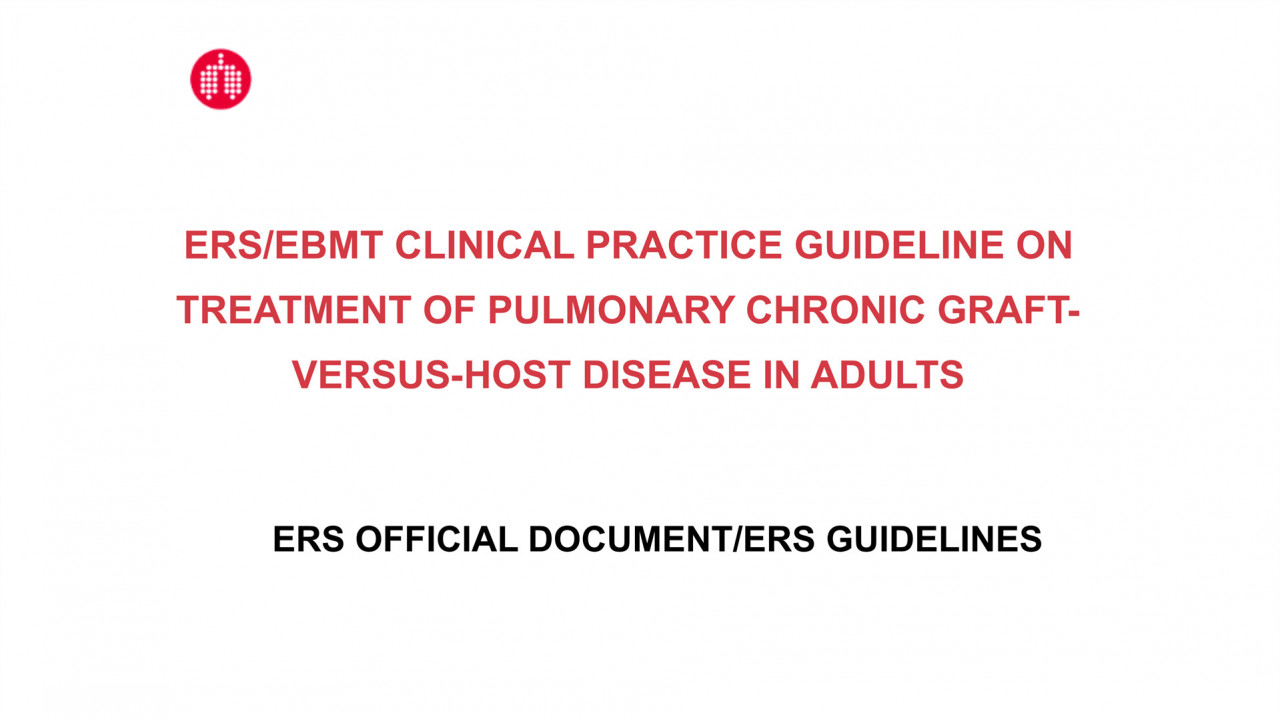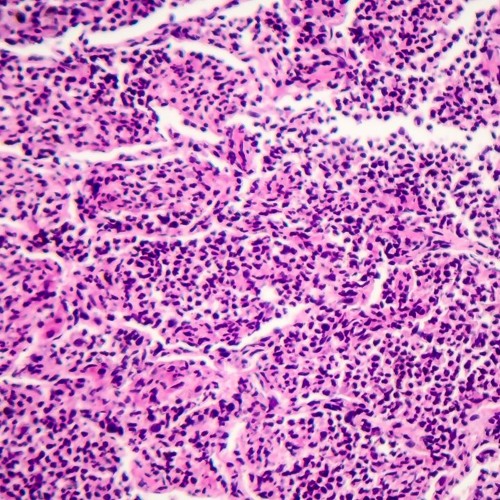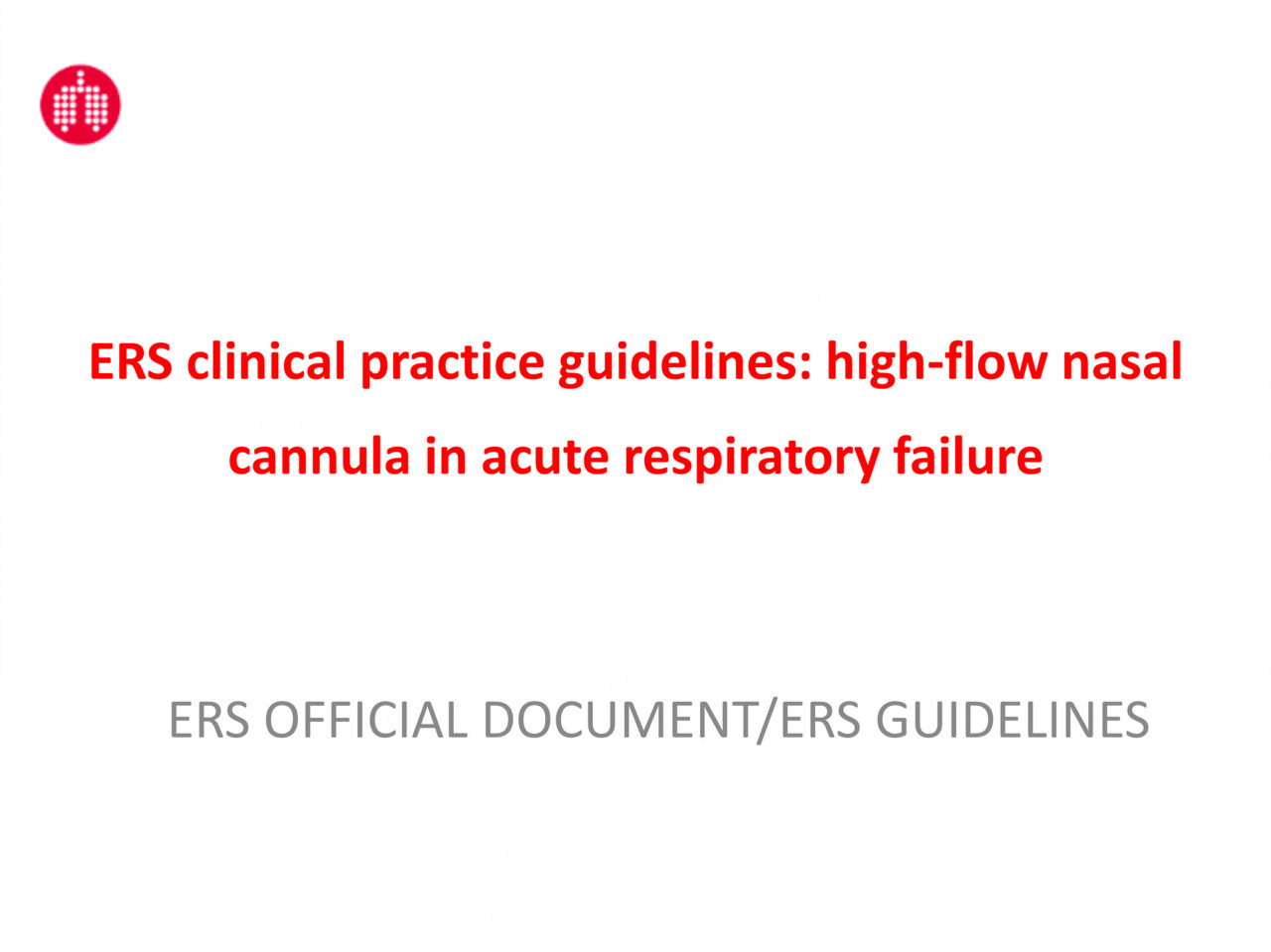List by date
ERS/EBMT clinical practice guideline on treatment of pulmonary chronic graft-versus-host disease in adults
European Respiratory Journal 2024; DOI: 10.1183/13993003.01727-2023 Chronic graft-versus-host disease (cGvHD) is a common complication after allogeneic haematopoietic stem cell transplantation, characterised by a broad disease spectrum that can affect virtually any organ. Although pulmonary cGvHD is a less common manifestation, it is of great concern due to its severity and poor prognosis. Optimal management of patients with pulmonary cGvHD is complicated and no standardised approach is available. The purpose of this joint European Respiratory Society and European Society for Blood and Marrow Transplantation Task Force was to develop evidence-based recommendations regarding the treatment of pulmonary cGvHD phenotype bronchiolitis obliterans syndrome in adults. A multidisciplinary group representing specialists in haematology, respiratory medicine, methodology as well as patient advocates formulated eight PICO (Patient, Intervention, Comparison, Outcome) and two narrative questions. Following the ERS standardised methodology, we conducted systematic reviews to address these questions and used the GRADE (Grading of Recommendations Assessment, Development and Evaluation) approach to develop recommendations. The resulting guideline addresses common therapeutic options (inhalation therapy, fluticasone-azithromycin-montelukast, imatinib, ibrutinib, ruxolitinib, belumosudil, extracorporeal photopheresis and lung transplantation), as well as other aspects of general management, such as lung functional and radiological follow-up and pulmonary rehabilitation, for adults with pulmonary cGvHD phenotype bronchiolitis obliterans syndrome. These recommendations include important advancements that could be incorporated in the management of adults with pulmonary cGvHD, primarily aimed at improving and standardising treatment and improving outcomes.
18 Mar 2024
Dyspnoea in acutely ill mechanically ventilated adult patients: an ERS/ESICM statement
European Respiratory Journal 2024 63: 2300347; DOI: 10.1183/13993003.00347-2023 This statement outlines a review of the literature and current practice concerning the prevalence, clinical significance, diagnosis and management of dyspnoea in critically ill, mechanically ventilated adult patients. It covers the definition, pathophysiology, epidemiology, short- and middle-term impact, detection and quantification, and prevention and treatment of dyspnoea. It represents a collaboration of the European Respiratory Society and the European Society of Intensive Care Medicine. Dyspnoea ranks among the most distressing experiences that human beings can endure. Approximately 40% of patients undergoing invasive mechanical ventilation in the intensive care unit (ICU) report dyspnoea, with an average intensity of 45?? mm on a visual analogue scale from 0 to 100?? mm. Although it shares many similarities with pain, dyspnoea can be far worse than pain in that it summons a primal fear response. As such, it merits universal and specific consideration. Dyspnoea must be identified, prevented and relieved in every patient. In the ICU, mechanically ventilated patients are at high risk of experiencing breathing difficulties because of their physiological status and, in some instances, because of mechanical ventilation itself. At the same time, mechanically ventilated patients have barriers to signalling their distress. Addressing this major clinical challenge mandates teaching and training, and involves ICU caregivers and patients. This is even more important because, as opposed to pain which has become a universal healthcare concern, very little attention has been paid to the identification and management of respiratory suffering in mechanically ventilated ICU patients.
01 Feb 2024
Nasal nitric oxide measurement in children for the diagnosis of primary ciliary dyskinesia: European Respiratory Society technical standard
European Respiratory Journal 2023 61: 2202031; DOI: 10.1183/13993003.02031-2022AbstractNasal nitric oxide (nNO) is extremely low in most people with primary ciliary dyskinesia (PCD) and its measurement is an important contributor to making the diagnosis. Existing guidelines and technical standards focus on nNO measurements in older, cooperative children using chemiluminescence analysers. However, measurements of nNO in pre-school-age children (age 2-5?? years) may facilitate early diagnosis and electrochemical rather than chemiluminescence analysers are widely used. Pre-schoolers often need different methods to be employed when measuring nNO. Hence, a European Respiratory Society Task Force has developed this technical standard as the first step towards standardising sampling, analysis and reporting of nNO measured as part of the diagnostic testing for PCD in all age groups, including pre-school-age children. Furthermore, we considered both chemiluminescence and electrochemical analysers that are in use worldwide. There was a paucity of quality evidence for electrochemical analysers and sampling methods used in young children, and the Task Force proposes future research priorities to allow updates of this technical standard.
06 Dec 2023
ERS Technical Standard for a Comprehensive High Quality Lung Cancer CT Screening Programme (DETeCCTS)
European Respiratory Journal 2023 61: 2300128; DOI: 10.1183/13993003.00128-2023AbstractBackground Screening for lung cancer with low radiation dose computed tomography (LDCT) has a strong evidence base. The European Council adopted a recommendation in November 2022 that lung cancer screening (LCS) be implemented using a stepwise approach. The imperative now is to ensure that implementation follows an evidence-based process that delivers clinical and cost-effectiveness. This European Respiratory Society (ERS) Task Force was formed to provide a technical standard for a high-quality LCS programme.Method A collaborative group was convened to include members of multiple European societies. Topics were identified during a scoping review and a systematic review of the literature was conducted. Full text was provided to members of the group for each topic. The final document was approved by all members and the ERS Scientific Advisory Committee.Results Topics were identified representing key components of a screening programme. The actions on findings from the LDCT were not included as they are addressed by separate international guidelines (nodule management and clinical management of lung cancer) and by a linked ERS Task Force (incidental findings). Other than smoking cessation, other interventions that are not part of the core screening process were not included (e.g. pulmonary function measurement). 56 statements were produced and areas for further research identified.Conclusions This European collaborative group has produced a technical standard that is a timely contribution to implementation of LCS. It will serve as a standard that can be used, as recommended by the European Council, to ensure a high-quality and effective programme.
06 Dec 2023
ERS Statement on frailty in adults with chronic lung disease
European Respiratory Journal 2023; DOI: 10.1183/13993003.00442-2023AbstractFrailty is a complex, multidimensional syndrome characterised by a loss of physiological reserves that increases a person's susceptibility to adverse health outcomes. Most knowledge regarding frailty originates from geriatric medicine, however, awareness of its importance as a treatable trait for people with chronic respiratory disease (including asthma, COPD and interstitial lung disease) is emerging. A clearer understanding of frailty and its impact in chronic respiratory disease is a pre-requisite to optimise clinical management in the future. This unmet need underpins the rationale for undertaking the present work.This European Respiratory Society Statement synthesises current evidence and clinical insights from international experts and people affected by chronic respiratory conditions regarding frailty in adults with chronic respiratory disease. The scope includes coverage of frailty within international respiratory guidelines, prevalence and risk factors, review of clinical management options (including comprehensive geriatric care, rehabilitation, nutrition, pharmacological and psychological therapies), and identification of evidence gaps to inform future priority areas of research. Frailty is under-represented in international respiratory guidelines, despite being common and related to increased hospitalisation and mortality. Validated screening instruments can detect frailty to prompt comprehensive assessment and personalised clinical management. Clinical trials targeting people with chronic respiratory disease and frailty are needed.
06 Dec 2023
ERS Statement on airway clearance techniques in adults with bronchiectasis
European Respiratory Journal 2023 62: 2202053; DOI: 10.1183/13993003.02053-2022AbstractAirway clearance techniques (ACTs) are part of the main management strategy for patients with bronchiectasis. Despite being a priority for patients, accessibility, implementation and reporting of ACTs are variable in clinical settings and research studies. This European Respiratory Society statement summarises current knowledge about ACTs in adults with bronchiectasis and makes recommendations to improve the future evidence base. A task force of 14 experts and two patient representatives (10 countries) determined the scope of this statement through consensus and defined six questions. The questions were answered based on systematic searches of the literature. The statement provides a comprehensive review of the physiological rationale for ACTs in adults with bronchiectasis, and the mechanisms of action along with the advantages and disadvantages of each ACT. Evidence on ACTs in clinical practice indicates that the most frequently used techniques are active cycle of breathing techniques, positive expiratory pressure devices and gravity-assisted drainage, although there is limited evidence on the type of ACTs used in specific countries. A review of 30 randomised trials for the effectiveness of ACTs shows that these interventions increase sputum clearance during or after treatment, reduce the impact of cough and the risk of exacerbations, and improve health-related quality of life. Furthermore, strategies for reducing the risk of bias in future studies are proposed. Finally, an exploration of patients' perceptions, barriers and enablers related to this treatment is also included to facilitate implementation and adherence to ACTs.
06 Dec 2023
Updated Technical Standards for the Measurement of Lung Volumes
European Respiratory Journal 2023 62: 2201519; DOI: 10.1183/13993003.01519-2022AbstractThis document updates the 2005 European Respiratory Society (ERS) and American Thoracic Society (ATS) technical standard for the measurement of lung volumes. The 2005 document integrated the recommendations of an ATS/ERS task force with those from an earlier National Heart, Lung, and Blood Institute workshop that led to the publication of background papers between 1995 and 1999 and a consensus workshop report with more in-depth descriptions and discussion. Advancements in hardware and software, new research and emerging approaches have necessitated an update to the 2005 technical standard to guide laboratory directors, physiologists, operators, pulmonologists and manufacturers. Key updates include standardisation of linked spirometry, new equipment quality control and validation recommendations, generalisation of the multiple breath washout concept beyond nitrogen, a new acceptability and grading system with addition of example tracings, and a brief review of imaging and other new techniques to measure lung volumes. Future directions and key research questions are also noted.
06 Dec 2023
ERS/ESTS/ESTRO/ESR/ESTI/EFOMP statement on management of incidental findings from low dose CT screening for lung cancer (MILCa)
European Respiratory Journal 2023 62: 2300533; DOI: 10.1183/13993003.00533-2023AbstractBackground Screening for lung cancer with low radiation dose computed tomography has a strong evidence base, is being introduced in several European countries and is recommended as a new targeted cancer screening programme. The imperative now is to ensure that implementation follows an evidence-based process that will ensure clinical and cost effectiveness. This European Respiratory Society (ERS) task force was formed to provide an expert consensus for the management of incidental findings which can be adapted and followed during implementation.
06 Dec 2023
Lung Function Initiative (GLI) reference equations for exhaled and nasal nitric oxide
European Respiratory Journal 2023; DOI: 10.1183/13993003.00370-2023 AbstractElevated levels of exhaled nitric oxide at a flow of 50?? mL·s−1 (FENO50) are an important indicator of Th2 airway inflammation and may aid clinicians in the diagnosis and monitoring of asthma. This study aimed to derive Global Lung Function Initiative reference equations and the upper limit of normal for FENO50.Available individual FENO50 data were collated and harmonised using consensus-derived variables and definitions. Data collected from individuals who met the harmonised definition of "healthy" were analysed using generalised additive models of location shape and scale (GAMLSS) technique.Data were retrospectively collated from 34 782 individuals from 34 sites in 15 countries, of whom 8022 met the definition of healthy (19 sites, 11 countries). Overall, height, age and sex only explained 12% of the between-subject variability of FENO50 (R2=0.12). The addition of NO device was a predictor of FENO50 and between-subject variability, such that the healthy range of values and the upper limit of normal varied depending on which device was used. The range of FENO50 values observed in healthy individuals was also very wide, and the heterogeneity was partially explained by the device used. The heterogeneity between sites remained within a sub-set of data where FENO50 was measured using the same device and a stricter definition of health (n=1027).Available FENO50 data collected from different sites using different protocols and devices was too variable to develop a single all-age reference equation. Further standardisation of NO devices and measurement is required before population reference values might be derived.
06 Dec 2023
European Respiratory Society Short Guidelines for the use of as-needed ICS/formoterol in mild Asthma
Recent clinical trials of as-needed fixed-dose combination of ICS/formoterol have provided new evidence that may warrant a reconsideration of current practice. A task force (TF) was set up by the European Respiratory Society to provide evidence-based recommendations on the use of as-needed ICS/formoterol as treatment for mild asthma. The TF defined two questions that were assessed using the Grading of Recommendations, Assessment, Development and Evaluation approach. The TF utilised the outcomes to develop recommendations for a pragmatic guideline for everyday clinical practice. The TF suggests that adults with mild asthma use as-needed ICS/formoterol instead of regular ICS maintenance treatment plus as-needed short-acting beta-2-antagonists (SABAs), and that adolescents with mild asthma use either as-needed ICS/formoterol or ICS maintenance treatment plus as-needed SABA (Conditional Recommendation; Low Certainty of Evidence). The recommendation for adults places a relatively higher value on the reduction of systemic corticosteroid use and the outcomes related to exacerbations and a relatively lower value on the small differences in asthma control. Either treatment options are suggested for adolescent patients as the balance is very close and data more limited. The TF recommends that adult and adolescent patients with mild asthma use as-needed ICS/formoterol instead of as-needed SABA (Strong Recommendation; Low Certainty of Evidence). This recommendation is based on the benefit of as-needed ICS/formoterol in mild asthma on several outcomes and the risks related to as-needed SABA in the absence of anti-inflammatory treatment. The implementation of this recommendation is hampered in countries (including European Union countries) where as-needed ICS/formoterol is not approved for mild asthma.
26 Sep 2023
ERS Clinical Practice Guideline: Palliative care for people with chronic obstructive pulmonary disease or interstitial lung disease
European Respiratory Journal 2023 62: 2202014; DOI: 10.1183/13993003.02014-2022 AbstractThere is increased awareness of palliative care needs in people with COPD or interstitial lung disease (ILD). This European Respiratory Society (ERS) task force aimed to provide recommendations for initiation and integration of palliative care into the respiratory care of adult people with COPD or ILD.The ERS task force consisted of 20 members, including representatives of people with COPD or ILD and informal caregivers. Eight questions were formulated, four in the Population, Intervention, Comparison, Outcome format. These were addressed with full systematic reviews and application of Grading of Recommendations Assessment, Development and Evaluation for assessing the evidence. Four additional questions were addressed narratively. An "evidence-to-decision" framework was used to formulate recommendations.The following definition of palliative care for people with COPD or ILD was agreed. A holistic and multidisciplinary person-centred approach aiming to control symptoms and improve quality of life of people with serious health-related suffering because of COPD or ILD, and to support their informal caregivers. Recommendations were made regarding people with COPD or ILD and their informal caregivers: to consider palliative care when physical, psychological, social or existential needs are identified through holistic needs assessment; to offer palliative care interventions, including support for informal caregivers, in accordance with such needs; to offer advance care planning in accordance with preferences; and to integrate palliative care into routine COPD and ILD care. Recommendations should be reconsidered as new evidence becomes available.
08 Jun 2023
ERS/ESICM/ESCMID/ALAT guidelines for the management of severe community-acquired pneumonia
European Respiratory Journal 2023 61: 2200735; DOI: 10.1183/13993003.00735-2022 Background Severe community-acquired pneumonia (sCAP) is associated with high morbidity and mortality, and while European and non-European guidelines are available for community-acquired pneumonia, there are no specific guidelines for sCAP. Materials and methodology The European Respiratory Society (ERS), European Society of Intensive Care Medicine (ESICM), European Society of Clinical Microbiology and Infectious Diseases (ESCMID) and Latin American Thoracic Association (ALAT) launched a task force to develop the first international guidelines for sCAP. The panel comprised a total of 18 European and four non-European experts, as well as two methodologists. Eight clinical questions for sCAP diagnosis and treatment were chosen to be addressed. Systematic literature searches were performed in several databases. Meta-analyses were performed for evidence synthesis, whenever possible. The quality of evidence was assessed with GRADE (Grading of Recommendations, Assessment, Development and Evaluation). Evidence to Decision frameworks were used to decide on the direction and strength of recommendations. Results Recommendations issued were related to diagnosis, antibiotics, organ support, biomarkers and co-adjuvant therapy. After considering the confidence in effect estimates, the importance of outcomes studied, desirable and undesirable consequences of treatment, cost, feasibility, acceptability of the intervention and implications to health equity, recommendations were made for or against specific treatment interventions. Conclusions In these international guidelines, ERS, ESICM, ESCMID and ALAT provide evidence-based clinical practice recommendations for diagnosis, empirical treatment and antibiotic therapy for sCAP, following the GRADE approach. Furthermore, current knowledge gaps have been highlighted and recommendations for future research have been made.
04 Apr 2023
ERS statement: a core outcome set for clinical trials evaluating the management of COPD exacerbations
European Respiratory Journal 2022 59: 2102006; DOI: 10.1183/13993003.02006-2021
09 Dec 2022
ERS statement on paediatric long-term noninvasive respiratory support
European Respiratory Journal 2022 59: 2101404; DOI: 10.1183/13993003.01404-2021
09 Dec 2022
ERS/ATS technical standard on interpretive strategies for routine lung function tests
European Respiratory Journal 2022 60: 2101499; DOI: 10.1183/13993003.01499-2021AbstractBackground Appropriate interpretation of pulmonary function tests (PFTs) involves the classification of observed values as within/outside the normal range based on a reference population of healthy individuals, integrating knowledge of physiological determinants of test results into functional classifications and integrating patterns with other clinical data to estimate prognosis. In 2005, the American Thoracic Society (ATS) and European Respiratory Society (ERS) jointly adopted technical standards for the interpretation of PFTs. We aimed to update the 2005 recommendations and incorporate evidence from recent literature to establish new standards for PFT interpretation.Methods This technical standards document was developed by an international joint Task Force, appointed by the ERS/ATS with multidisciplinary expertise in conducting and interpreting PFTs and developing international standards. A comprehensive literature review was conducted and published evidence was reviewed.Results Recommendations for the choice of reference equations and limits of normal of the healthy population to identify individuals with unusually low or high results are discussed. Interpretation strategies for bronchodilator responsiveness testing, limits of natural changes over time and severity are also updated. Interpretation of measurements made by spirometry, lung volumes and gas transfer are described as they relate to underlying pathophysiology with updated classification protocols of common impairments.Conclusions Interpretation of PFTs must be complemented with clinical expertise and consideration of the inherent biological variability of the test and the uncertainty of the test result to ensure appropriate interpretation of an individual's lung function measurements.
09 Dec 2022
European Respiratory Society statement on long COVID follow-up
European Respiratory Journal 2022 60: 2102174; DOI: 10.1183/13993003.02174-2021
09 Dec 2022
Idiopathic Pulmonary Fibrosis (an Update) and Progressive Pulmonary Fibrosis in Adults: An Official ATS/ERS/JRS/ALAT Clinical Practice Guideline
Background: This American Thoracic Society, European Respiratory Society, Japanese Respiratory Society, and Asociación Latinoamericana de Tórax guideline updates prior idiopathic pulmonary fibrosis (IPF) guidelines and addresses the progression of pulmonary fibrosis in patients with interstitial lung diseases (ILDs) other than IPF.Methods: A committee was composed of multidisciplinary experts in ILD, methodologists, and patient representatives. 1) Update of IPF: Radiological and histopathological criteria for IPF were updated by consensus. Questions about transbronchial lung cryobiopsy, genomic classifier testing, antacid medication, and antireflux surgery were informed by systematic reviews and answered with evidence-based recommendations using the Grading of Recommendations, Assessment, Development and Evaluation (GRADE) approach. 2) Progressive pulmonary fibrosis (PPF): PPF was defined, and then radiological and physiological criteria for PPF were determined by consensus. Questions about pirfenidone and nintedanib were informed by systematic reviews and answered with evidence-based recommendations using the GRADE approach.Results: 1) Update of IPF: A conditional recommendation was made to regard transbronchial lung cryobiopsy as an acceptable alternative to surgical lung biopsy in centers with appropriate expertise. No recommendation was made for or against genomic classifier testing. Conditional recommendations were made against antacid medication and antireflux surgery for the treatment of IPF. 2) PPF: PPF was defined as at least two of three criteria (worsening symptoms, radiological progression, and physiological progression) occurring within the past year with no alternative explanation in a patient with an ILD other than IPF. A conditional recommendation was made for nintedanib, and additional research into pirfenidone was recommended.Conclusions: The conditional recommendations in this guideline are intended to provide the basis for rational, informed decisions by clinicians.Keywords: idiopathic pulmonary fibrosis; progressive pulmonary fibrosis; radiology; histopathology
08 Dec 2022
Syndrome of Combined Pulmonary Fibrosis and Emphysema: An Official ATS/ERS/JRS/ALAT Research Statement
Background: The presence of emphysema is relatively common in patients with fibrotic interstitial lung disease. This has been designated combined pulmonary fibrosis and emphysema (CPFE). The lack of consensus over definitions and diagnostic criteria has limited CPFE research.Goals: The objectives of this task force were to review the terminology, definition, characteristics, pathophysiology, and research priorities of CPFE and to explore whether CPFE is a syndrome.Methods: This research statement was developed by a committee including 19 pulmonologists, 5 radiologists, 3 pathologists, 2 methodologists, and 2 patient representatives. The final document was supported by a focused systematic review that identified and summarized all recent publications related to CPFE.Results: This task force identified that patients with CPFE are predominantly male, with a history of smoking, severe dyspnea, relatively preserved airflow rates and lung volumes on spirometry, severely impaired DlCO, exertional hypoxemia, frequent pulmonary hypertension, and a dismal prognosis. The committee proposes to identify CPFE as a syndrome, given the clustering of pulmonary fibrosis and emphysema, shared pathogenetic pathways, unique considerations related to disease progression, increased risk of complications (pulmonary hypertension, lung cancer, and/or mortality), and implications for clinical trial design. There are varying features of interstitial lung disease and emphysema in CPFE. The committee offers a research definition and classification criteria and proposes that studies on CPFE include a comprehensive description of radiologic and, when available, pathological patterns, including some recently described patterns such as smoking-related interstitial fibrosis.Conclusions: This statement delineates the syndrome of CPFE and highlights research priorities.
08 Dec 2022
ERS clinical practice guidelines: high-flow nasal cannula in acute respiratory failure
Abstract Background High-flow nasal cannula (HFNC) has become a frequently used noninvasive form of respiratory support in acute settings; however, evidence supporting its use has only recently emerged. These guidelines provide evidence-based recommendations for the use of HFNC alongside other noninvasive forms of respiratory support in adults with acute respiratory failure (ARF). Materials and methodology The European Respiratory Society task force panel included expert clinicians and methodologists in pulmonology and intensive care medicine. The task force used the GRADE (Grading of Recommendations, Assessment, Development and Evaluation) methods to summarise evidence and develop clinical recommendations for the use of HFNC alongside conventional oxygen therapy (COT) and noninvasive ventilation (NIV) for the management of adults in acute settings with ARF. Results The task force developed eight conditional recommendations, suggesting the use of 1) HFNC over COT in hypoxaemic ARF; 2) HFNC over NIV in hypoxaemic ARF; 3) HFNC over COT during breaks from NIV; 4) either HFNC or COT in post-operative patients at low risk of pulmonary complications; 5) either HFNC or NIV in post-operative patients at high risk of pulmonary complications; 6) HFNC over COT in nonsurgical patients at low risk of extubation failure; 7) NIV over HFNC for patients at high risk of extubation failure unless there are relative or absolute contraindications to NIV; and 8) trialling NIV prior to use of HFNC in patients with COPD and hypercapnic ARF. Conclusions HFNC is a valuable intervention in adults with ARF. These conditional recommendations can assist clinicians in choosing the most appropriate form of noninvasive respiratory support to provide to patients in different acute settings.
06 Dec 2022






